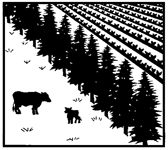U.S. Department of Agriculture: Forest Service -- National Agroforestry Center
Date of this Version
November 1997
Abstract
Forestry and livestock grazing are common competing uses for non-irrigated lands around the world. Forest grazing is a traditional practice in most of North America. Approximately 25 percent of all US forest land is grazed by livestock. Young forests and mature open-canopied forests can provide considerable amounts of forage for livestock. Prescription grazing makes beneficial use of ground vegetation that would otherwise compete with trees for soil moisture and nutrients, harbor gnawing rodents, and pose a fire hazard. Pasture grasses and legumes are sometimes seeded into newly harvested forest areas to reduce erosion, to provide high-quality food for deer and elk, and to decrease establishment of unwanted trees and brush. Such seedings provide a forage base, which may not persist without livestock grazing. Older, closed canopy stands of trees are frequently thinned to increase tree and forage growth. Pastures may contain a few scattered large trees or small groves of trees that were left when the land was cleared. Together, these traditional practices form a base of experience from which current, more intensely managed, silvopastoral systems have evolved.


Comments
Published by National Agroforestry Center, USDA Forest Service, Rocky Mountain Station, USDA Natural Resources Conservation Service, East Campus – UNL, Lincoln, Nebraska 68583-0822.